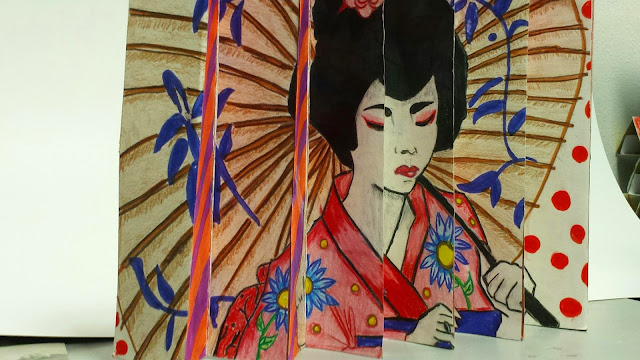Last time we tried this lesson was Spring 2012. Here is the
link. Directions are the same.
Students generate two artworks, both horizontal. Colored and attached to a triangular poster board base. Here are some steps.
Two-View Box
Fred Mintert – Knobnoster 2010 Carthage Junior High School
Adapted from “Scratch Art® 3-VU ®”
I saw this idea in the Dick Blick catalog, but at 24 dollars for 6, it was unfeasible. I re-engineered the lesson so it cost pennies instead of dollars. Instructions below are for two 8x10 images. Must be drawn horizontally.
Materials : Heavy poster board cut to 31x 8 in, 8x 10 drawing paper, hot glue, white glue
Instructions: Using rulers, students are to measure and draw the following measurements on the board. They need to be parallel and perpendicular for this to work well. The marks should be made with a ballpoint pen with pressure, so they are not just drawing the marks, but also scoring the line. This makes folding 20 times easier/accurate. Also add the number 1-5 and Letters A and B where shown. This is the plan for attaching the images.
On the reverse side, you also need the following marks. Do not score these.
After these marks are made and scored, then the board is folded, sort of like an accordion. If you are using one sided poster board, make sure the white side is facing out, with the notations. Using hot glue, the students pair up and help each other glue down the triangles, starting on the interior, the last one being the tab (glued under.)The point of the triangle is glued down on the marks you made on the backside. This will form five 2” equilateral triangular box forms.
After this, flip over the two 8x10 in drawings, and again, with a ruler, divide into 2 inch wide strips, 5 total, from top to bottom, like this. Also lightly add the numbers and letters as shown.
After they are noted, they are carefully cut apart on the lines. To finish, simply glue the 2” strip on the same side of the triangle that has the same number and letter. Make sure they aren’t place on upside-down. Also, I find that laying the strip down on scrap paper, then smoothing out the glue for an even coat makes them stick better and more accurately.
Display: For the separate images to appear, you tilt the box side to side. So if you are putting on a wall, secure with heavy duty glue or tacks, at eye level.















































